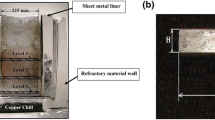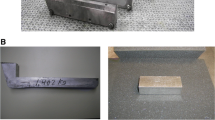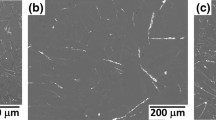Abstract
Impact toughness as a property has been acquiring increased importance in recent years, since data regarding this property can provide a means for assessing alloy ductility under high rates of deformation. The main objective of this study is to investigate the effects of Sr-modification, Fe-based intermetallic phases and aging conditions on the impact toughness of widely used 356 alloys. The total absorbed energy was measured using a computer-aided instrumented Instron Charpy impact testing machine. Increasing the level of iron additions decreases the impact energy values of 356 alloys to a noticeable degree (~35–57%). The addition of 0.1 wt% Mn to non-modified 356 alloys seems to have no observable effect on the impact energy, while increasing the Mn addition to 0.4 wt% produces a slight improvement in the impact energy values for non-modified and Sr-modified 356 alloys compared to that of those containing only iron under the same conditions. The application of solution heat treatment in combination with Sr-modification was found to significantly improve the impact energy of as-cast 356 alloys, particularly at low iron additions. Artificial aging of non-modified and Sr-modified 356 alloys at 180 °C diminishes the impact energy values with an increase in the aging time up to 8 h compared to those obtained under the solution heat-treated conditions. On the other hand, aging at 220 °C for 12 h increases the impact energy values of Sr-modified 356 alloy containing 0.12 wt% Fe and combined 0.2 wt% Fe–0.1 wt% Mn to about 20 and 18 J, respectively. The fracture behavior of non-modified 356 alloys containing 0.12 wt% Fe is mainly controlled by the acicular eutectic Si particles whereas β-iron platelets act as crack initiation sites and provide further path for final crack propagation in non-modified 356 alloys containing 0.9 wt% Fe. The β-iron platelets and π-iron phase particles contribute largely to crack initiation and propagation in the Sr-modified 356 alloys containing 0.9 wt% Fe.














Similar content being viewed by others
References
Samuel AM, Samuel FH, Doty HW (1996) J Mater Sci 31:5529. doi:10.1007/BF01159327
Bäckerud L, Chai G, Tamminen J (1990) Solidification characteristics of aluminum alloys. Vol. 2: foundry alloys. AFS/Skanaluminium, Des Plaines, IL, p 71
Taylor JA Cooperative report, research center for cast metals manufacturing (CAST). University of Queensland, Brisbane, Australia, p 1
Paray F, Gruzleski JE (1994) Cast Met 7(1):29
Martin JW, Doherty RD (1997) Stability of microstructure in metallic systems. Cambridge University Press, Cambridge, p 239
El Sebaie O, Samuel FH, Samuel AM, Doty HW (2008) Mater Sci Eng A 480(1–2):342
Taylor JA, StJohn DH, Barresi J, Couper MJ (2000) Mater Sci Forum 331–337:277
Taylor A, StJohn DH, Zheng LH, Barresi J, Couper MJ (2001) Alum Trans 4–5:111
Wang QG, Davidson CJ (2001) J Mater Sci 36:739. doi:10.1023/A:1004801327556
Ma Z, Samuel AM, Samuel FH, Doty HW, Valtierra S (2002) AFS Trans Paper 03–101:1
Sigworth G, Apelian D, Shivkumar S (1989) AFS Trans 97:811
Shivkumar S, Wang L, Keller C (1994) J Mater Eng Perform 3:83
Merlin M, Timelli G, Bonollo F, Garagnani GL (2009) J Mater Process Technol 209:1060
Gruzleski JE, Closset BM (1990) The treatment of liquid aluminum–silicon alloys. American Foundrymen’s Society, Des Plaines, IL, p 74
Zhang DL, Zheng LH, StJohn DH (2002) J Light Met 2:7
Dieter GE (1986) Mechanical metallurgy. McGraw Hill, UK, p 241
Smallman RE, Ngan AHW (2007) Physical metallurgy and advanced materials. Butterworth Heinemann, Boston, p 385
Nakayama Y, Ninomiya K, Ohnishi N (1998) J Jap Inst Light Met 48(7):340
Tsukuda M, Koike S, Harada M (1978) J Jap Inst Light Met 28(1):8
Sreeja Kumari SS, Pillai RM, Pai BC (2007) Mater Sci Eng A 460–461:561
Sreeja Kumari SS, Pillai RM, Pai BC (2002) Indian Found J 48(1):27
Awano Y, Shimizu Y (1990) AFS Trans 98:889
Murali S, Raman KS, Murthy KSS (1994) Int J Cast Met Res 6(4):189
Wang QG, Cáceres CH (1998) Mater Sci Eng A A241:72
Brooks CR, Choudhury A (1993) Metallurgical failure analysis. McGraw-Hill Inc., New York
Ran G, Zhou JE, Wang QG (2008) J Mater Process Technol 207:46
Acknowledgements
Financial and in-kind support received from the Natural Sciences and Engineering Research Council of Canada (NSERC), General Motors Power Train Group (USA), and Corporativo Nemak (Mexico), is gratefully acknowledged. The authors would also like to thank Mr. Lang Shi of the Microanalysis Laboratory, Earth and Planetary Science, McGill University for carrying out the EPMA analysis.
Author information
Authors and Affiliations
Corresponding author
Rights and permissions
About this article
Cite this article
Elsebaie, O., Samuel, A.M. & Samuel, F.H. Effects of Sr-modification, iron-based intermetallics and aging treatment on the impact toughness of 356 Al–Si–Mg alloy. J Mater Sci 46, 3027–3045 (2011). https://doi.org/10.1007/s10853-010-5181-1
Received:
Accepted:
Published:
Issue Date:
DOI: https://doi.org/10.1007/s10853-010-5181-1




